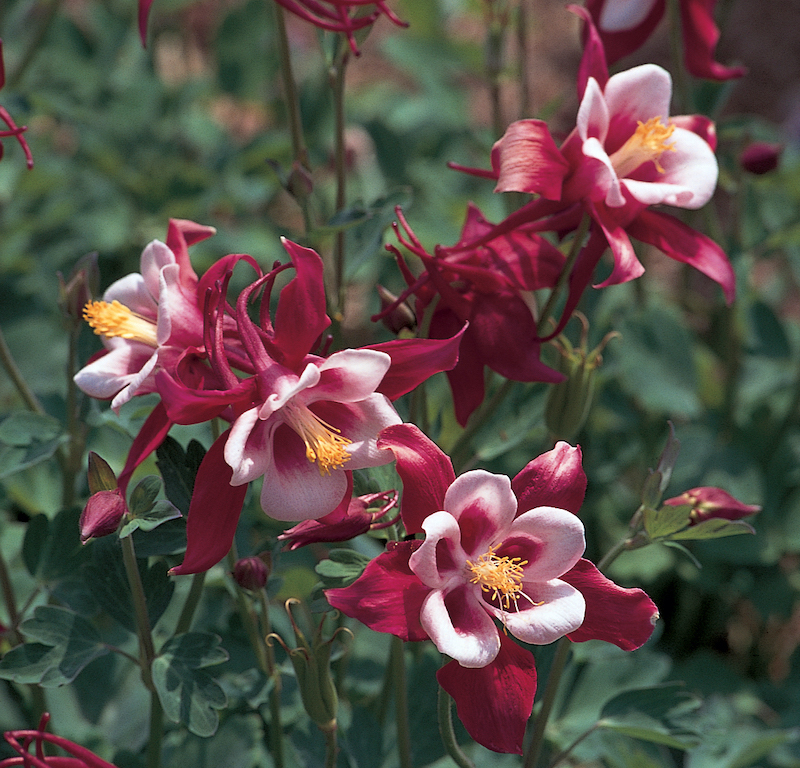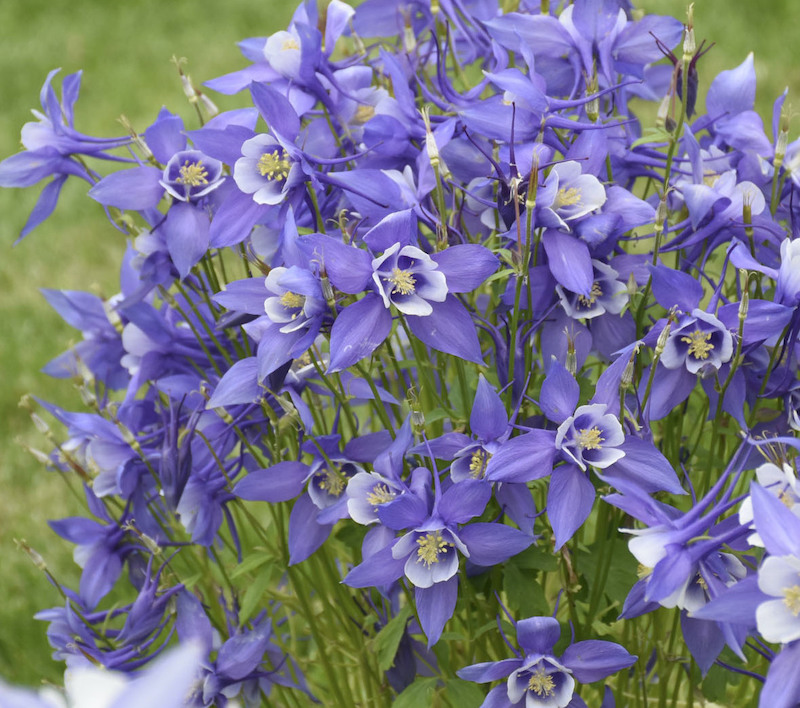Columbine are herbaceous perennials native to North America, from the Baja in California all of the way to the Yukon in Alaska. Aquilegia is the scientific name and there are two specific varieties native to North America. Aquilegia canadensis, commonly known as eastern red columbine, is found east of the Mississippi River.
Aquilegia formosa, commonly called western red columbine, is found along the west coast all of the way up to the Yukon in Alaska. These popular spring bloomers are fairly easy to grow with very little maintenance. The bright single and bi-colors of hybrid Columbine mix well with any spring bulb and blooming shrub such as Forsythia, Azalea and Daphne. Columbine are typically found in woodland areas and prefer to grow in part shade or dappled sun with protection from the heat of the late afternoon, especially in the warmer hardiness zones.
Even Though Columbine is perennial and returns reliably every spring, it goes dormant in the summer. Make sure to plan on planting another perennial nearby that can cover any gap in the garden after Columbine goes dormant. Another solution would be to move a piece of garden art or planted container into the empty garden spot.

Planting Columbine
Columbine likes to be planted in soil that is not very rich or too far to either end of the pH scale. Well-drained soil is necessary, especially in the winter. Container-grown Columbine needs to be planted at the same depth as the pot and does best if planted very early in the spring, just as the new growth emerges.Water in new plants well to get rid of any air gaps and to fully moisten the surrounding soil. Fertilizing does not need to be done at planting time.
Use a 2-3 inch layer of organic compost as a mulch around the base of the plant. This mulch will help to keep the soil moist and cool around the root zone. The most common disease to affect Columbine is powdery mildew, which is spread by plants growing too close together. Give the plants plenty of room to mature and still have adequate air circulation.

Watering Plants
Columbine prefers soil that is moist, while also very well drained. Watering to keep this balance is the most important step to ensuring these plants survive and become well established. When Columbine is well established it will become more drought tolerant and not require much supplemental watering in the summer. A long, deep watering two times a week will encourage roots to grow deeper into the soil and make them less likely to dry out quickly.
Aim for providing 1 inch of total water each week for newly planted perennials. Using drip irrigation or soaker hoses directs the water directly to the soil, preventing both evaporation in the air and wetting of the leaves. Diseases such as mildews and fungus spread more easily on wet foliage, and the spray can wash the spores onto unaffected leaves.
Fertilizing Columbine
The native varieties of Columbine, such as Aquilegia canadensis or ‘Little Lanterns Columbine’, do not usually require supplemental fertilizing. They will benefit from a layer of organic compost or shredded leaves spread around the root zone in the spring as new growth emerges. The more ornamental hybrid varieties appreciate a supplemental feeding with a slow-release, balanced fertilizer, which will support healthy foliage and flower growth.
Using quick-acting liquid fertilizer will encourage extremely thick and weak growth that is more susceptibe to sap sucker pests like aphids. Always follow manufacturer recommended amounts; applying more fertilizer than recommended is wasteful and may contaminate stormwater and underground water supplies over time.

Pruning Columbine
Cutting back Columbine helps the plant to put growing energy into the roots, resulting in a more vigorous plant every year. Columbine typically only blooms for a couple weeks in the spring and then sets seed early in the summer. Deadheading the spent blooms will reduce self-seeding and keep the plants tidy while they prepare to go dormant for the summer. When foliage begins to turn brown, the whole plant can be cut back to 3-4 inch above the soil. Cutting back Columbine early will prevent any diseases from spreading and over-wintering in the soil.
Caring for Columbine in Pots
Container-grown Columbine is a great way to add color to a mixed seasonal display or to highlight a particular hybrid variety. All container-grown plants need to have regular watering and possibly extra fertilizing to keep them growing vigorously. Select pots with excellent drainage so that the plant's roots are not sitting in standing water and the potting soil has enough air. Do not use garden soil in containers. It tends to be too heavy and not free draining.
An all-purpose potting soil will have perlite or vermiculite added for drainage and for lightening the texture. Feeding container-grown Columbines needs to be done on a monthly basis until they start to go dormant for the summer. An organic fish emulsion or liquid kelp fertilizer diluted with water in a watering can will support both blooming and strong plant structure.
Winter Care for Columbine
Columbine needs minimal maintenance over the winter. This is a very hardy perennial that is available for just about every growing zone in the United States. Generally, the plants have already gone dormant before the first frosts of the fall. Trim any dead foliage and stems, leaving 2-3 inches standing above the soil. Mulching with organic compost or leaves will help to insulate the roots and mark where the plants are over the winter.
Container-grown Columbine rarely requires extra watering. Place pots in an area exposed to rain, but not washed out if the rain is heavy. Placing pots up on bricks or dedicated ‘pot feet’ will assist with drainage and prevent accumulation of standing water.
Common Columbine Care Questions
Do Columbine Do Better in Sun or Shade?
Columbine do love the sun, but they don't love the heat. Full sun is great for columbine unless you're in southern states or warmer climates, then they'll appreciate partial shade and some mulch to help keep their roots cool.
Should Columbine Be Cut Back After Blooming?
Deadheading columbine will encourage additional blooming. Cutting them back in the fall to prevent self-seeding is preferable for some, but allowing them to self-sow isn't all bad as they are short-lived plants with an average life expectancy of 3 to 4 years.
Why Is My Columbine Turning Yellow?
It is normal for columbine to be yellow after blooming, especially if it's been a hot, dry summer. Cutting them back to the ground if you wish is fine. The plant may not show any new growth until spring and if it doesn't, that does not mean it is dead.
Why Are My Columbine Leaves Turning White?
White leaves on columbine may be due to powdery mildew, which can be combated by watering in the morning, not watering from overhead, increasing air circulation around the plants, removing and discarding infected leaves, and spraying the plants with baking soda, and water, dish soap, and horticultural oil mix. If the white sections of the leaves appear to be little trails, you likely have leaf miners. You can either remove and discard the affected leaves or kill the miners by pressing the leaves between your fingers where ever the trails are visible.
Have a question about Columbine? Fill out the form below and we will try and get back to your question as soon as possible. We may even feature your question in this article to help other gardeners!
 |
Author Robbin Small - Published 7-12-2022 |
